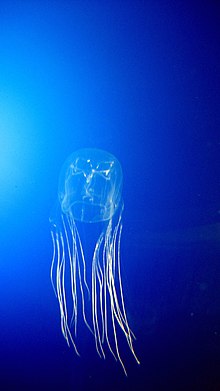Chirodropidae: Difference between revisions
Content deleted Content added
No edit summary Tags: Mobile edit Mobile web edit Advanced mobile edit |
Citation bot (talk | contribs) Alter: journal. Add: pmc, volume, doi-access, bibcode, pmid, authors 1-1. Removed proxy/dead URL that duplicated identifier. Removed parameters. Some additions/deletions were parameter name changes. | Use this bot. Report bugs. | Suggested by Headbomb | Linked from Wikipedia:WikiProject_Academic_Journals/Journals_cited_by_Wikipedia/Sandbox | #UCB_webform_linked 351/525 |
||
| Line 12: | Line 12: | ||
}} |
}} |
||
'''Chirodropidae''' is a family of [[Venom (poison)|venom]]ous [[box jellyfish]] within the class [[Cubozoa]]. Like other members of the order [[Chirodropida]], they have branched pedalia (muscular bases at the corners of their cubic umbrella), in contrast to the unbranched pedalia of box jellyfish in the order [[Carybdeida]]. Each branch houses its own individual tentacle.<ref>{{Cite journal| |
'''Chirodropidae''' is a family of [[Venom (poison)|venom]]ous [[box jellyfish]] within the class [[Cubozoa]]. Like other members of the order [[Chirodropida]], they have branched pedalia (muscular bases at the corners of their cubic umbrella), in contrast to the unbranched pedalia of box jellyfish in the order [[Carybdeida]]. Each branch houses its own individual tentacle.<ref>{{Cite journal|last1=Cartwright|first1=P|last2=Halgedahl|first2=S. L.|last3=Hendricks.|first3=J. R.|last4=Jarrard|first4=R. D.|last5=Marques|first5=A. C.|last6=Collins|first6=A. G.|last7=Lieberman|first7=B. S.|date=2007-10-31|title=Exceptionally Preserved Jellyfishes from the Middle Cambrian|journal=PLOS ONE|volume=2|issue=10|pages=e1121|pmc=2040521| doi=10.1371/journal.pone.0001121|pmid=17971881|bibcode=2007PLoSO...2.1121C|issn=1932-6203|doi-access=free}}</ref> Nematocyst composition and type can vary among individuals within this family based on body size and life stage.<ref>{{Cite journal|last1=Oba|first1=A.|last2=Hidaka|first2=M.|last3=Iwanaga|first3=S.|date=2004|editor-last=Fautin|editor-first=D. G.|editor2-last=Westfall|editor2-first=J. A.|editor3-last=Cartwrigh|editor3-first=P.|editor4-last=Daly|editor4-first=M.|editor5-last=Wyttenbach|editor5-first=C. R.|title=Nematocyst composition of the cubomedusan ''Chiropsalmus quadrigatus'' changes with growth|url=https://link.springer.com/chapter/10.1007/978-1-4020-2762-8_21|journal=Coelenterate Biology 2003|series=Developments in Hydrobiology|volume=178 |language=en|location=Dordrecht|publisher=Springer Netherlands|pages=173–177|doi=10.1007/978-1-4020-2762-8_21|isbn=978-1-4020-2762-8}}</ref> Like other box jellyfish, chirodropids can be found in coastal and shallow marine areas, but they have also been found to occur at benthic depths.<ref>{{Cite journal|last1=Keesing|first1=J.K.|last2=Strzelecki|first2=J.|last3=Stowar|first3=M.|last4=Wakeford|first4=M.|last5=Miller|first5=K. J.|last6=Gershwin|first6=L.|last7=Liu|first7=D.|date=2016-02-29|title=Abundant box jellyfish, ''Chironex'' sp. (Cnidaria: Cubozoa: Chirodropidae), discovered at depths of over 50 m on western Australian coastal reefs|journal=Scientific Reports|language=en|volume=6|issue=1|pages=22290|doi=10.1038/srep22290|pmid=26924604 |pmc=4770284 |bibcode=2016NatSR...622290K |issn=2045-2322}}</ref> |
||
[[File:Chirodropus gorilla.jpg|thumb|''Chirodropus gorilla'']] |
[[File:Chirodropus gorilla.jpg|thumb|''Chirodropus gorilla'']] |
||
Revision as of 22:34, 12 June 2022
| Chirodropidae | |
|---|---|

| |
| Chironex sp. | |
| Scientific classification | |
| Domain: | Eukaryota |
| Kingdom: | Animalia |
| Phylum: | Cnidaria |
| Class: | Cubozoa |
| Order: | Chirodropida |
| Family: | Chirodropidae Haeckel, 1880 |
| Genera | |
| |
Chirodropidae is a family of venomous box jellyfish within the class Cubozoa. Like other members of the order Chirodropida, they have branched pedalia (muscular bases at the corners of their cubic umbrella), in contrast to the unbranched pedalia of box jellyfish in the order Carybdeida. Each branch houses its own individual tentacle.[1] Nematocyst composition and type can vary among individuals within this family based on body size and life stage.[2] Like other box jellyfish, chirodropids can be found in coastal and shallow marine areas, but they have also been found to occur at benthic depths.[3]

Genera
- Chirodectes Gershwin, 2006
- Chirodectes maculatus (Cornelius, Fenner & Hore, 2005)
- Chirodropus Haeckel, 1880
- Chirodropus gorilla Haeckel, 1880
- Chirodropus palmatus Haeckel, 1880
- Chironex Southcott, 1956
- Chironex fleckeri Southcott, 1956
- Chironex indrasaksajiae Sucharitakul, 2017
- Chironex yamaguchii Lewis & Bentlage, 2009
References
- ^ Cartwright, P; Halgedahl, S. L.; Hendricks., J. R.; Jarrard, R. D.; Marques, A. C.; Collins, A. G.; Lieberman, B. S. (2007-10-31). "Exceptionally Preserved Jellyfishes from the Middle Cambrian". PLOS ONE. 2 (10): e1121. Bibcode:2007PLoSO...2.1121C. doi:10.1371/journal.pone.0001121. ISSN 1932-6203. PMC 2040521. PMID 17971881.
- ^ Oba, A.; Hidaka, M.; Iwanaga, S. (2004). Fautin, D. G.; Westfall, J. A.; Cartwrigh, P.; Daly, M.; Wyttenbach, C. R. (eds.). "Nematocyst composition of the cubomedusan Chiropsalmus quadrigatus changes with growth". Coelenterate Biology 2003. Developments in Hydrobiology. 178. Dordrecht: Springer Netherlands: 173–177. doi:10.1007/978-1-4020-2762-8_21. ISBN 978-1-4020-2762-8.
- ^ Keesing, J.K.; Strzelecki, J.; Stowar, M.; Wakeford, M.; Miller, K. J.; Gershwin, L.; Liu, D. (2016-02-29). "Abundant box jellyfish, Chironex sp. (Cnidaria: Cubozoa: Chirodropidae), discovered at depths of over 50 m on western Australian coastal reefs". Scientific Reports. 6 (1): 22290. Bibcode:2016NatSR...622290K. doi:10.1038/srep22290. ISSN 2045-2322. PMC 4770284. PMID 26924604.
- "Chirodropidae". Integrated Taxonomic Information System.
- Lewis, C. and B. Bentlage (2009). Clarifying the identity of the Japanese Habu-kurage, Chironex yamaguchii, sp nov (Cnidaria: Cubozoa: Chirodropida). Zootaxa 2030: 59–65
